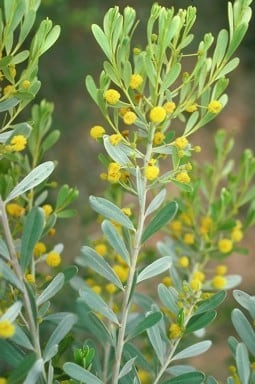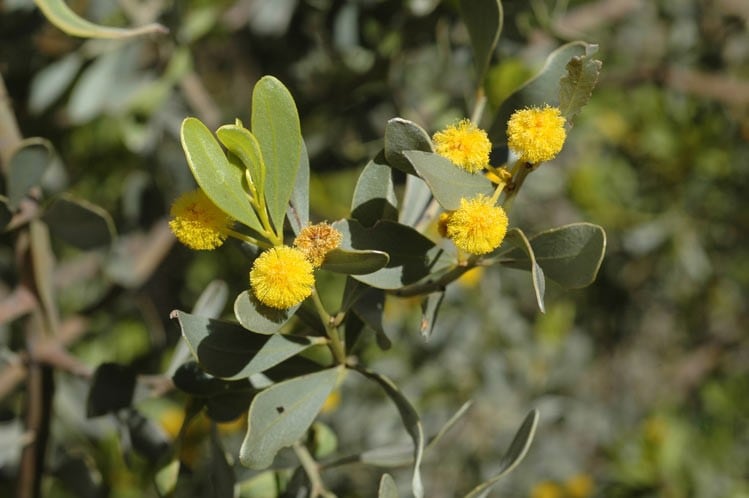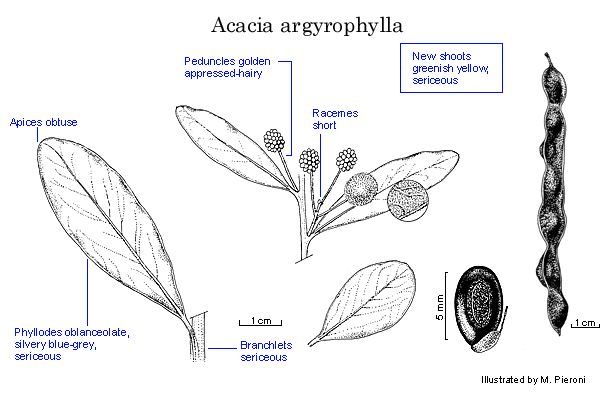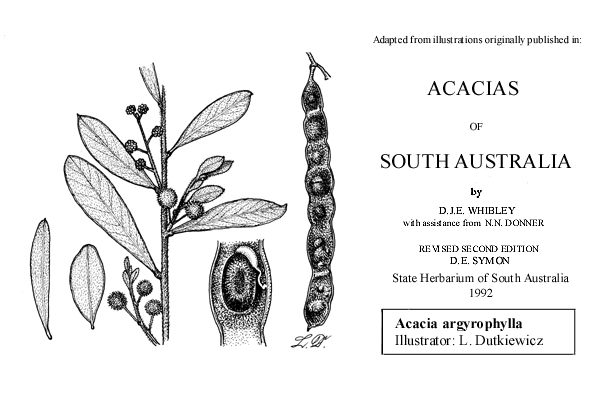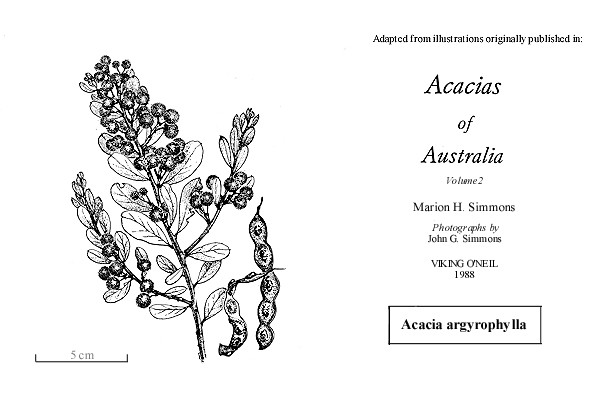Acacia argyrophylla Hook.
WATTLE
Acacias of Australia
Common Name
Silver Mulga
Family
Fabaceae
Distribution
Occurs in S.A. from the Flinders Ranges near Hawker S to Monarto and the western Murray mallee region, with isolated populations occurring on the Yorke Peninsula and Onkaparinga Gorge. An isolated occurrence from near Coromby, Vic., is now presumed extinct, fide A.B.Court, in J.H.Willis, Handb. Pl. Victoria 2: 222 (1973).
Description
Dense shrub 2–3 m high and often the same in diam., closely allied to A. dictyocarpa but differing mainly in the following ways: New shoots sericeous with bright greenish yellow hairs. Penultimate branchlets sericeous with white hairs. Phyllodes oblanceolate, 2.5–5 (–6) cm long, 6–15 (–25) mm wide, sometimes to 6 cm long and 2.5 cm wide at base of branchlets, l:w = 2–4.5, obtuse, silvery blue-grey due to sericeous indumentum of silvery white hairs completely covering the lamina. Inflorescences racemose with axes normally (1–) 4–10 (–35) mm long and with dense appressed greenish golden hairs; peduncles (5–) 7–15 (–19) mm long, with indumentum as on racemes except hairs occasionally silvery white; heads 25–45-flowered. Pods 7–10 (–15) mm wide. Seeds 5–7 mm long.
Habitat
It grows on low hills and slopes in woodland and mallee, often in alkaline soils.
Specimens
S.A.: Loxton, T.R.N.Lothian s.n. (AD9620781); l.5 km N of Monarto South on the road to Monarto, B.R.Maslin 5974 (AD, K, PERTH); 36.3 km E of Kimba, J.G. & M.H.Simmons 1140 (AD); Onkaparinga Recreation Park, R.Taplin 370 (AD, PERTH); 32 km NE of Hawker, R.F.Telfer 6 (AD); near Minlaton, D.J.E.Whibley 6200 (AD). Vic.: near Coromby, 5 Oct. 1892, F.Reader 3 (MEL).
Notes
Notes on biological and ecological features, and utilisation potential, of A. argyrophylla are provided in B.R.Maslin and M.W.McDonald, AcaciaSearch: Evaluation of Acacia as a woody crop option for southern Australia, RIRDC Publication No. 03/017, 40–43 (2004).
The status of A. argyrophylla deserves further attention. J.H.Maiden, Forest Fl. New South Wales 6(3): 47, pl. 2000 (1914), treated it as a variety of A. brachybotrya, but later considered it a distinct species, fide J. & Proc. Roy. Soc. New South Wales 53: 202 (1920).
As defined here, A. argyrophylla is narrowly circumscribed. It is a member of the ‘A. brachybotrya group’ and is most readily distinguished from A. dictyocarpa by generally longer phyllodes which are densely clothed with silky appressed hairs (bright greenish yellow on new shoots, silvery white on mature phyllodes). Some specimens of A. dictyocarpa, especially those from the Yorke Peninsula, S.A., may possess certain of these characters but they do not occur in combination as in A. argyrophylla. However, in some cases hybridity between the two species is suspected. Related to A. brachybotrya which is most reliably distinguished by its patent branchlet hairs and generally shorter phyllodes.
Acacia semiaurea may be a hybrid involving, perhaps, A. retinodes and A. argyrophylla or A. dictyocarpa; see note under A. dictyocarpa. Also, scattered hybrids between A. argyrophylla and A. euthycarpa occur in areas where the geographic ranges of these two species overlap.
FOA Reference
Data derived from Flora of Australia Volumes 11A (2001), 11B (2001) and 12 (1998), products of ABRS, ©Commonwealth of Australia
Author
Edited by B.R.Maslin
B.R.Maslin
This identification key and fact sheets are available as a mobile application:
URL: https://apps.lucidcentral.org/wattle/
© Copyright 2018. All rights reserved.



